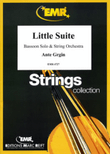Details
-
- Genres:
- Classical
-
- Format:
- Score Set of Parts Score and Parts
- Item types:
- Physical
- Level:
- Intermediate
- Usages:
- School and Community
SKU: CN.R30002
For String Orchestra. Composed by D. Wright. Arranged by Dennis Wright. Orchestra Music. Score and parts. Duration 12:25. G & M Brand Music Publishers #R30002. Published by G & M Brand Music Publishers (CN.R30002).A masterwork for string orchestra. Holst's Moorside Suite was composed in 1928, near the end of the composer's life, and is a masterpiece of his maturity. Originally for brass band, Moorside Suite retains the folk-song charm that is representative of Holst.
A Moorside Suite is a masterpiece of Holst's maturity. Written in 1928, 6 years before his death, it achieves a synthesis of his creative talent as a composer with the strong folk-song influences of 20 years earlier. The title of the work alludes to a country setting but does not describe an exact location, and this is mirrored in the musical material. Folk-song influence is apparent but not overt. The work was originally for brass band, commissioned for the National Brass Band Championships held at the Crystal Palace, London, Englan. Denis Wright was a musical scholar, and the transcription was carried out either during Holst's lifetime or shortly after his death in 1934. The score was not published until 1983, and has been re-edited by Geoffrey Brand. Interestingly, Holst himself always intended the work to be transcribed for 'Military Band' and a 1st Movement and some bars of the 2nd Movement exist in manuscript in the British Library. The opening Scherzo belies the serious nature of the work. It is a light, airy 6/8 in which the initial statement, with its all-important leap of a fifth, is first heard on clarinet and alto saxophone. This interval of a fifth is distilled, as if to draw our attention to it, before a fortissimo 8 bars in which the opening theme is repeated - the only fortissimo passage in the whole of the 1st movement. Holst achieves a 'folky,' almost modal, feel in the melody by allowing the 6th of the scale to remain natural. Whereas the 1st movement has a sylph-like delicacy, the second is at rest. Tranquil, especially in the beadth of the chorale, its simple key structure distills the tonal tension inherent in the tonic/dominant polarity. The oboe opening (again delineating the rising fifth of the first movement) is in F minor: a short cornet echo leads to C major for the first statement of the chorale. This leads back to F minor and a subtle development of the opening followed by the Chorale again this time in F minor and now allowed to build to a fortissimo climax before the movement fragments around the falling 6th of the opening. The peace is shattered by a triumphant March. We are in Bb minor again, and this movement is built on thematic contrasts: firstly the 'pesante' theme, then a hammered fanfare, followed by a playful leggiero tune. Like the Scherzo, this March has a Trio, the melody of which bears a definite resemblance to the Chorale of the 2nd movement. Most certainly, this linking device was subconscious on Holst's part, but with the predominant use of the interval of a fifth, it helps to explain the feeling that the Suite is thematically tightly-knit.
SKU: CN.R30002
For String Orchestra. Composed by D. Wright. Arranged by Dennis Wright. Orchestra Music. Score and parts. Duration 12:25. G & M Brand Music Publishers #R30002. Published by G & M Brand Music Publishers (CN.R30002).A masterwork for string orchestra. Holst's Moorside Suite was composed in 1928, near the end of the composer's life, and is a masterpiece of his maturity. Originally for brass band, Moorside Suite retains the folk-song charm that is representative of Holst.
A Moorside Suite is a masterpiece of Holst's maturity. Written in 1928, 6 years before his death, it achieves a synthesis of his creative talent as a composer with the strong folk-song influences of 20 years earlier. The title of the work alludes to a country setting but does not describe an exact location, and this is mirrored in the musical material. Folk-song influence is apparent but not overt. The work was originally for brass band, commissioned for the National Brass Band Championships held at the Crystal Palace, London, Englan. Denis Wright was a musical scholar, and the transcription was carried out either during Holst's lifetime or shortly after his death in 1934. The score was not published until 1983, and has been re-edited by Geoffrey Brand. Interestingly, Holst himself always intended the work to be transcribed for 'Military Band' and a 1st Movement and some bars of the 2nd Movement exist in manuscript in the British Library. The opening Scherzo belies the serious nature of the work. It is a light, airy 6/8 in which the initial statement, with its all-important leap of a fifth, is first heard on clarinet and alto saxophone. This interval of a fifth is distilled, as if to draw our attention to it, before a fortissimo 8 bars in which the opening theme is repeated - the only fortissimo passage in the whole of the 1st movement. Holst achieves a 'folky,' almost modal, feel in the melody by allowing the 6th of the scale to remain natural. Whereas the 1st movement has a sylph-like delicacy, the second is at rest. Tranquil, especially in the beadth of the chorale, its simple key structure distills the tonal tension inherent in the tonic/dominant polarity. The oboe opening (again delineating the rising fifth of the first movement) is in F minor: a short cornet echo leads to C major for the first statement of the chorale. This leads back to F minor and a subtle development of the opening followed by the Chorale again this time in F minor and now allowed to build to a fortissimo climax before the movement fragments around the falling 6th of the opening. The peace is shattered by a triumphant March. We are in Bb minor again, and this movement is built on thematic contrasts: firstly the 'pesante' theme, then a hammered fanfare, followed by a playful leggiero tune. Like the Scherzo, this March has a Trio, the melody of which bears a definite resemblance to the Chorale of the 2nd movement. Most certainly, this linking device was subconscious on Holst's part, but with the predominant use of the interval of a fifth, it helps to explain the feeling that the Suite is thematically tightly-knit.
Ratings + Reviews
- Explain exactly why you liked or disliked the product. Do you like the artist? Is the transcription accurate? Is it a good teaching tool?
- Consider writing about your experience and musical tastes. Are you a beginner who started playing last month? Do you usually like this style of music?
- Feel free to recommend similar pieces if you liked this piece, or alternatives if you didn't.
- Be respectful of artists, readers, and your fellow reviewers. Please do not use inappropriate language, including profanity, vulgarity, or obscenity.
- Avoid disclosing contact information (email addresses, phone numbers, etc.), or including URLs, time-sensitive material or alternative ordering information.
- We cannot post your review if it violates these guidelines. If you have any suggestions or comments on the guidelines, please email us.
- All submitted reviews become the licensed property of Sheet Music Plus and are subject to all laws pertaining thereto. If you believe that any review contained on our site infringes upon your copyright, please email us.
- Read Sheet Music Plus's complete Privacy Policy
Tell A Friend
Tell a friend (or remind yourself) about this product. We'll instantly send an email containing product info and a link to it. You may also enter a personal message.
We do not use or store email addresses from this form for any other purpose than sending your share email.
Read our Privacy Policy.
Learn about MP3s
Learn about Smart Music
Learn about Digital Video
You may also like
-
$55.00
-
$25.00
-
$20.00
-
$37.95
-
$12.99
-
$125.00
-
$27.00
-
$75.00
-
$70.00
-
$55.00
-
$70.00
-
$70.00
-
$68.95
-
$115.00
-
$85.00
-
$85.00
-
$110.00
-
$35.00
-
$85.00
-
$35.00
Recommended Products Based on A Moorside Suite
-
$125.00
-
$25.00
-
$27.00
-
$75.00
-
$55.00
-
$70.00
-
$70.00
-
$68.95
-
$115.00
-
$85.00
-
$85.00
-
$110.00
-
$35.00
-
$85.00
-
$35.00
-
$55.00
-
$55.00
-
$75.00
-
$45.00
-
$55.00
Top-selling in
-
$47.99
-
$4.50
-
$4.99
-
$19.95
-
$29.99
-
$2.99
-
$12.95
-
$3.50
-
$15.25
-
$15.25
-
$10.95
-
$55.00
-
$2.99
-
$16.95
-
$565.00
-
$2.99
-
$525.00
-
$14.95














































